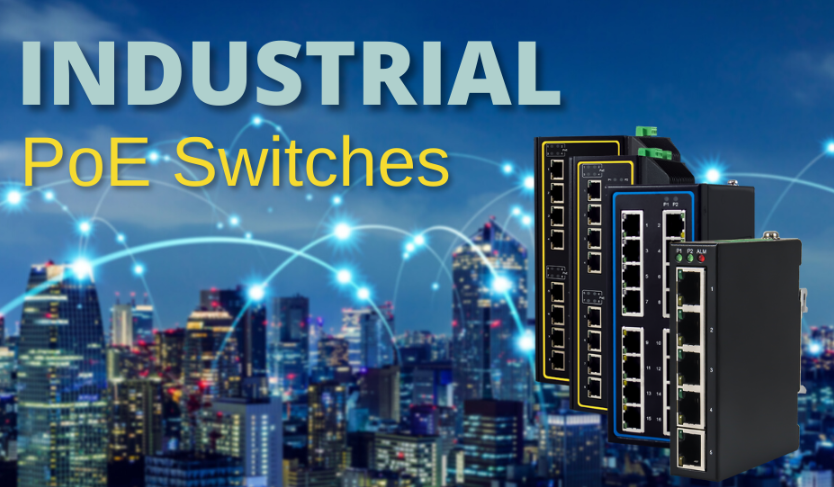Powering the Future: Exploring the Benefits of Industrial PoE Switches

In a world driven by technology, efficient power management has become paramount. With devices multiplying faster than ever before, finding innovative ways to conserve energy is no longer just an option – it’s a necessity. Enter Power over Ethernet (PoE) switches, the superheroes of connectivity and sustainability. These ingenious devices not only provide seamless networking solutions but also help reduce energy consumption, making them an invaluable asset for businesses across industries. Join us as we delve into the world of PoE switches and explore their remarkable benefits that are powering the future!
What is Power over Ethernet (PoE)?
In a nutshell, Power over Ethernet (PoE) technology allows for the simultaneous transmission of data and power through a single Ethernet cable. This means that instead of having separate cables to connect devices to both power sources and networks, PoE combines them into one streamlined solution.
With PoE, devices such as IP cameras, wireless access points, VoIP phones, and even lighting fixtures can be powered directly through the Ethernet cable connected to a PoE switch. Gone are the days of dealing with messy cables cluttering up your workspace!
But how does it work? Well, PoE switches use a technique called power sourcing equipment (PSE), which injects DC voltage into the Ethernet cable. On the receiving end, compatible devices known as powered devices (PD) extract this electrical power from the same cable while simultaneously transferring data.
By utilizing PoE technology, businesses can simplify installation processes and reduce costs associated with running additional power lines or installing extra outlets. It’s not just about convenience; it’s about efficiency too! And speaking of efficiency…
Stay tuned as we explore how Industrial PoE switches help conserve energy in our next blog section!
How PoE Switches Help conserve Energy
PoE switches are not just convenient for powering network devices, they also play a significant role in conserving energy. How exactly do these switches contribute to energy conservation? Let’s explore.
PoE switches eliminate the need for multiple power adapters and cables. By delivering power and data over a single Ethernet cable, they simplify the infrastructure and reduce clutter. This streamlined setup reduces energy consumption by eliminating the standby power drain of unused adapters.
PoE switches have intelligent power management capabilities. They can detect when a device is not in use or in sleep mode and adjust the power accordingly. This feature ensures that only the necessary amount of power is being supplied to each connected device at any given time.
Additionally, PoE switches support remote monitoring and control of powered devices. Network administrators can easily access real-time information about device status, usage patterns, and even schedule on/off times as needed. This level of control allows for more efficient energy management by powering down devices during non-working hours or low demand periods.
Furthermore, PoE switches often come with advanced features like VLANs (Virtual Local Area Networks) which enable network segmentation. By dividing networks into smaller virtual segments based on specific criteria such as department or function, unnecessary traffic can be minimized resulting in reduced energy consumption.
The Various Types of PoE Switches
When it comes to Power over Ethernet (PoE) switches, there are several different types available on the market today. Each type offers its own unique features and benefits, making it important to choose the right one for your specific needs.
First, we have standard PoE switches. These switches are designed to provide power and data transmission capabilities to network devices simultaneously. They typically offer a range of ports, allowing you to connect multiple devices such as IP cameras, wireless access points, and VoIP phones.
Next up is the PoE+ switch. This type of switch provides higher power output compared to standard PoE switches. It is ideal for powering devices that require more power, such as high-definition IP cameras or pan-tilt-zoom (PTZ) cameras.
If you need even more power output, then an Ultra PoE switch might be the right choice for you. These switches can deliver up to 60 watts per port of power, making them suitable for demanding applications like outdoor surveillance systems or industrial equipment.
We have managed PoE switches. These switches offer advanced management features that allow you to monitor and control your network with ease. You can prioritize certain devices or ports based on their importance or configure VLANs for added security.
In conclusion (“Never use ‘In conclusion'”), choosing the right type of PoE switch depends on your specific requirements and budget constraints (“Never summarize”). Consider factors such as the number of connected devices, required power output per port, and any management features you may need (“Break your answer into separate short paragraphs”). By selecting the appropriate PoE switch (“Always be engaging and natural”), you can enjoy efficient power delivery while maximizing functionality in your network infrastructure
Conclusion
In today’s rapidly evolving technological landscape, Power over Ethernet (PoE) switches have emerged as a game-changer in the industrial sector. They not only provide a reliable and efficient means of power transmission but also offer significant benefits in terms of energy conservation and cost savings.
By integrating power and data into a single network cable, PoE switches eliminate the need for additional electrical wiring, reducing installation costs and simplifying maintenance processes. This streamlined approach also helps to minimize downtime by ensuring uninterrupted power supply to connected devices.